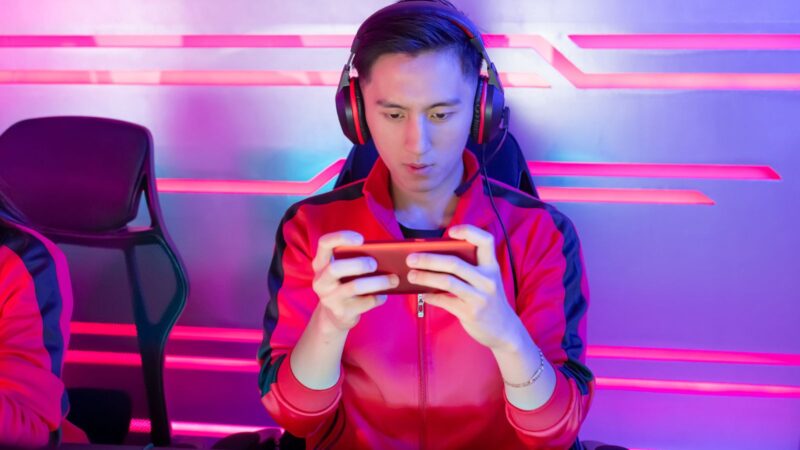Understanding and Forecasting Trends in Mobile Gaming Behavior
This article delves into the intriguing realm of Mobile Gaming Behavior. It’s not just about high scores and virtual victories; it’s about understanding how these digital diversions impact our lives, shape our social interactions, and influence our choices. From casual gamers to hardcore enthusiasts, the mobile gaming landscape is as diverse as it is captivating.
Join us as we unlock the secrets of Mobile Gaming Behavior, exploring the reasons behind its addictive allure and the profound effects it can have on our everyday lives. You might be surprised to discover that your gaming habits reveal more about you than you ever imagined.
Mobile Gaming Behavior
The surging popularity of mobile gaming demonstrates its embedment in modern life. Worldwide, mobile games now make up 60% of revenue for the global games market, a clear testament to the burgeoning domain’s significance.

Mobile gaming picked up and strongly flourished with the release of landmark games, like ‘Candy Crush Saga’ and ‘Angry Birds’. They introduced an audience broadening mix of casual gaming, transcending age and gender boundaries. Since then, every passing year sees more downloads, increased revenue, and a record-breaking number of active gamers.
Securing its position at the forefront of the digital Age, mobile gaming evolution correlates with advancements in mobile technology. As smartphones and tablets became more powerful, they accommodated more sophisticated games. From simple puzzle games, the mobile gaming world expanded to incorporate complex RPGs, Battle Royale Games, and even AR-based games, like ‘Pokémon Go’, which tapped into geolocation features and augmented reality capabilities to give gamers a unique, immersive gaming experience.

Additionally, the rise of mobile gaming stands partially attributed to the App stores. Distributing games became easier than ever, inducing more developers to produce mobile games. Indie game developers prospered, adept at creating distinctive, engaging games that captured players’ imaginations.
Riding the wave of social connectivity, mobile games don’t hesitate to integrate social media features. They encourage players to connect and compete with their friends, fostering a sense of community among gamers. In-app purchases offer competitive advantages in games and also serve as a significant revenue source for game developers. The increasing focus on mobile games by traditional gaming powerhouses like Nintendo also indicates the sector’s escalating importance.
Combine the convenience, personalization, and connectivity mobile gaming offers, and it’s not hard to perceive why it’s experiencing such phenomenal growth.
However, further exploration of Mobile Gaming Behavior could present a richer understanding of its meteoric rise.
Understanding Mobile Gaming Behavior
Mobile Gaming Behavior showcases a rich tapestry of user habits, preferences, and engagements, deeply rooted in the flexibility and accessibility of mobile devices. An evaluation of gaming patterns, specifically, reveals two predominant behavioral types: Casual gamers, characterized by infrequent, leisurely playtimes, and Hardcore gamers, defined by lengthy, intensive gaming sessions. The casual player base comprises games like ‘Crossy Road’ and ‘Subway Surfers’, while hardcore gamers often gravitate towards competitive titles like ‘PUBG Mobile’ and ‘Clash Royale’.

Time of usage differs significantly across demographic groups, for instance, young adults frequently engage in night-time gaming sessions, patchwork gaming throughout the day proves popular among professionals. Statistics from eMarketer suggest adults spend an average of 23 minutes each day, a testament to the influence of smartphone gaming.
The gaming environment takes precedence in shaping behavior. Single-player games, like ‘Monument Valley’, tend to encourage solitary, focused playing while multiplayer games, such as ‘Among Us’ and ‘Call of Duty Mobile’, stimulate social interaction and team strategizing. Variables like game design, level of challenge, storyline quality, and graphics affect player retention and engagement levels.

In-app purchases, an essential element in modern gaming, influence behavior significantly. It’s observable that a fair number of players, lured by the prospect of gameplay advantages, routinely make purchases. According to a Deloitte report, 69% of gamers made at least one in-app purchase in the past year. Such microtransactions contribute significantly to the gaming industry’s revenue, increasing developers’ focus on freemium models and in-app monetization.
Lastly, the impact of gaming behavior on lifestyle can’t be ignored. Frequent gaming sessions might foster sedentary habits and lead to ineffective time management, particularly among younger gamers. Conversely, the introduction of augmented reality-based games like ‘Pokémon Go’ offer novel ways to combine physical activity with gaming.
In sum, understanding Mobile Gaming Behavior necessitates examining factors like player types, time of usage, gaming environment, in-app purchases, and lifestyle impacts. This quintessential insights help shape e future game development, marketing strategies, and industry policy regulations.
Impact of Mobile Gaming on Society
The proliferation of mobile games influences society to an extensive degree, with the phenomenon resulting in both significant positive and negative effects on social structures, behaviors, and the economy.

Let’s start with the positive aspects. Mobile gaming exercises cognitive skills, contributes to hand-eye coordination, and stimulates critical thinking. Puzzle games such as Candy Crush Saga and Angry Birds exemplify this, testing players’ strategic abilities and mental agility. Mobile gaming also fosters global connections, bridging geographical boundaries by enabling people worldwide to engage in multiplayer games, like Players Unknown Battle Grounds (PUBG). Furthermore, mobile games provide a source of relaxation, stress reduction, and engagement for many people. Top casual games like Subway Surfers and Clash of Clans exemplify this aspect.
On the economic front, mobile games encourage local and international commerce as they frequently draw revenue through in-app purchases. According to Sensor Tower, consumers spent a whopping $111 billion on in-app purchases in 2020, evidencing the industry’s huge revenue generation potential.

However, the societal impact of mobile games isn’t all rosy. They can trigger compulsive play, leading to gaming addiction — a recognized mental disorder according to the World Health Organization. Extreme cases involve individuals neglecting family, studies, or work, significantly impacting personal and professional lives.
Moreover, games involving in-app purchases can lead to financial issues. An investigation by The Guardian found that some players, lured by the ‘free-to-play’ model, sink thousands into games without realizing the extent of their spending.
While weighing these impacts, keep in mind that the quality of the gaming experience — whether it enriches or detracts from players’ lives — depends largely on moderation and individual gaming behavior. Hence, knowledge and understanding of these influences hold critical value, aiding in the development of effective game designs and regulatory mechanisms in the gaming industry.
The Role of Technology in Shaping Mobile Gaming Behavior
Technology plays a pivotal part in redesigning the Mobile Gaming Behavior, with advancements such as AI, AR/VR, and cloud gaming being major difference-makers.

AI’s Contribution to Mobile Gaming
AI or Artificial Intelligence redefines interactive gaming, providing personalized experiences to gamers. It facilitates adaptive learning models, in games like ‘Shadow of the Tomb Raider’, enhancing players’ challenges based on their expertise level. AI also contributes to building more intelligent and unpredictable enemies, giving rise to a rich and immersive game environment.
Influence of AR/VR on Mobile Gaming
Augmented Reality (AR) and Virtual Reality (VR) elevate players’ gaming experiences to another dimension. By rendering 3D game characters and environments in the real world, AR games like ‘Pokemon Go’ have captivated millions of players worldwide. On the other hand, VR games such as ‘The Room VR: A Dark Matter’ enhance the immersive gaming experience, making gamers feel that they’re at the heart of the action.

Impact of Cloud Gaming on Mobile Gaming Behavior
Cloud gaming marks a significant stride in mobile gaming. It rids gamers of the need for high-end gaming equipment, allowing games to run on servers while streaming to devices — a feature seen in Google’s Stadia. This broadens the reach of resource-heavy and sophisticated games to a larger audience, altering the gaming behavior landscape altogether.
Role of 5G in Mobile Gaming
The introduction of 5G technology enables a faster, seamless gaming experience without the constraints of lag and latency. It boosts the performance of multiplayer games, providing a platform for more streamlined, real-time gameplay. It also paves the way for more AR and VR content in mobile gaming, further enriching the gaming behavior, as seen in games like ‘Fortnite’.
Advanced technology indubitably shapes Mobile Gaming Behavior. Offering improved, personalized, and immersive gaming experiences, it continually attracts a wider audience to the mobile gaming world. With newer technological advancements on the horizon, Mobile Gaming Behavior can be expected to reshape further, defining the future of the gaming industry.
Safeguarding Good Gaming Practice
Technological advancements fundamentally derive Mobile Gaming Behavior, but concurrently amplify the need for safeguarding good gaming practices. This necessity is paramount in fostering a healthy gaming environment, securing user data, and averting possible gaming addiction and cyberbullying instances. Eschewing this responsibility can harbor detrimental circumstances for mobile gamers.

Promoting a healthy gaming environment involves maintaining a balance between gameplay and other daily life activities. Educational initiatives, such as China’s recent policy restricting minors’ gaming to three hours per week, exemplify an attempt to regulate and encourage balanced gaming habits.
Securing user data is another focal point. As data breaches, phishing scams, and malware attacks remain prevalent threats, robust encryption and security measures are indispensable. These include secure user authentication, preventative measures like Two-Factor Authentication (2FA), stringent data encryption protocols, all contributing to secure gaming sessions.
Preventing gaming addiction remains a concern as well. Designing games with playtime limits or warning notifications after extended play periods could discourage addictive gaming behavior. Games like “Hooked Inc: Fisher Tycoon” employ these strategies, offering ample breaks prolonging non-stop gameplay.

Addressing cyberbullying rounds out the need for safeguarding good gaming practices. Gaming platforms providing moderation tools and strict community guidelines can effectively combat this issue. Platforms like “Roblox” illustrate this, leveraging automated chat filters and live moderators to ensure a safe gaming experience.
In sum, safeguarding good gaming practices is an intricate interplay between promoting healthy gaming habits, secure gaming platforms, deterring addiction, and combating cyberbullying. Achieving these endeavors fosters a safer, healthier mobile gaming environment, thereby better shaping the future of the mobile gaming industry.
Future Trends in Mobile Gaming Behavior
Hyper-casual games serve as a window into the future, providing a sneak peek into the changing trends. Types of games like these, characterized by easy-to-understand game mechanics and quick progression, continue to gain momentum. Take, for instance, the popularity of games like ‘Among Us’ and ‘Fall Guys,’ both defining this category.

Integration of innovative technologies into games forms a significant part of the shift. Augmented Reality, for example, is likely to merge the real world with virtual gaming landscapes, a concept aptly demonstrated by ‘Pokemon Go’. Concurrently, Virtual Reality continues the quest for enhanced game immersion, potentially transforming the gameplay experiences. Games like ‘Moss’ and ‘Beat Saber’ exemplify this trend.
Inclusive mobile gaming is another trend on the rise. Developers increasingly design games to be suitable for a broad spectrum of users, including children, the elderly, and those with specific needs. For instance, they’re designing games like ‘Toca Life World’ and ‘Prodigy Math Game’ considering the distinct needs and preferences of those age groups.

Game developers pay heed to the growing concern over gaming addiction, prompting the introduction of mechanics that encourage healthy gameplay. Significant changes include restrictions on playtime, especially for underage gamers. Examples of this trend can be seen in ‘PUBG Mobile’ and ‘Honor of Kings.’
Finally, there looms an undeniable shift towards cloud-based gaming services. Providers like ‘Google Stadia’ and ‘Microsoft’s Project xCloud’ are expected to render conventional console-based gaming obsolete. This stride towards cloud gaming boosts accessibility, eliminates the need for expensive hardware, and introduces a subscription-based revenue model.
Suffice it to say, the future landscape of Mobile Gaming Behavior is an ever-changing tableau, shaped by both developer innovation and player response. Each step taken in these various directions aims to make the mobile gaming industry more dynamic, inclusive, and safe.





